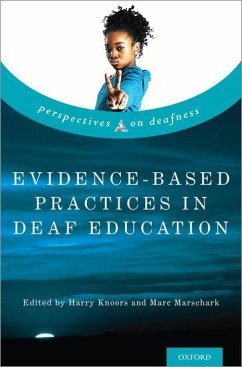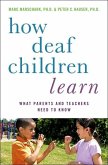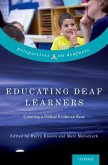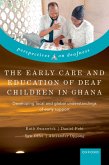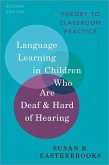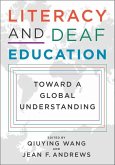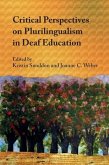Evidence-Based Practices in Deaf Education
Herausgeber: Knoors, Harry; Marschark, Marc
Evidence-Based Practices in Deaf Education
Herausgeber: Knoors, Harry; Marschark, Marc
- Gebundenes Buch
- Merkliste
- Auf die Merkliste
- Bewerten Bewerten
- Teilen
- Produkt teilen
- Produkterinnerung
- Produkterinnerung
This volume presents the latest research from internationally recognized researchers and practitioners on language, literacy and numeracy, cognition, and social and emotional development of deaf learners.
Andere Kunden interessierten sich auch für
![How Deaf Children Learn How Deaf Children Learn]() Marc Marschark (, Center for Research on Educational Partnerships,How Deaf Children Learn52,99 €
Marc Marschark (, Center for Research on Educational Partnerships,How Deaf Children Learn52,99 €![Educating Deaf Learners Educating Deaf Learners]() Educating Deaf Learners200,99 €
Educating Deaf Learners200,99 €![The Early Care and Education of Deaf Children in Ghana The Early Care and Education of Deaf Children in Ghana]() Ruth Swanwick (Professor of Deaf Educa Professor of Deaf EducationThe Early Care and Education of Deaf Children in Ghana132,99 €
Ruth Swanwick (Professor of Deaf Educa Professor of Deaf EducationThe Early Care and Education of Deaf Children in Ghana132,99 €![Language Learning in Children Who Are Deaf and Hard of Hearing Language Learning in Children Who Are Deaf and Hard of Hearing]() Susan R. Easterbrooks (Emerita Professor, Emerita Professor, GeorgiLanguage Learning in Children Who Are Deaf and Hard of Hearing102,99 €
Susan R. Easterbrooks (Emerita Professor, Emerita Professor, GeorgiLanguage Learning in Children Who Are Deaf and Hard of Hearing102,99 €![Literacy and Deaf Education Literacy and Deaf Education]() Qiuying WangLiteracy and Deaf Education104,99 €
Qiuying WangLiteracy and Deaf Education104,99 €![Critical Perspectives on Plurilingualism in Deaf Education Critical Perspectives on Plurilingualism in Deaf Education]() Critical Perspectives on Plurilingualism in Deaf Education60,99 €
Critical Perspectives on Plurilingualism in Deaf Education60,99 €![The Proper Way to Educate the Deaf The Proper Way to Educate the Deaf]() The Abbe Charles-Michel de l'EpeeThe Proper Way to Educate the Deaf76,99 €
The Abbe Charles-Michel de l'EpeeThe Proper Way to Educate the Deaf76,99 €-
-
-
This volume presents the latest research from internationally recognized researchers and practitioners on language, literacy and numeracy, cognition, and social and emotional development of deaf learners.
Hinweis: Dieser Artikel kann nur an eine deutsche Lieferadresse ausgeliefert werden.
Hinweis: Dieser Artikel kann nur an eine deutsche Lieferadresse ausgeliefert werden.
Produktdetails
- Produktdetails
- Perspectives on Deafness
- Verlag: Oxford University Press Inc
- Seitenzahl: 664
- Erscheinungstermin: 25. September 2018
- Englisch
- Abmessung: 236mm x 163mm x 51mm
- Gewicht: 998g
- ISBN-13: 9780190880545
- ISBN-10: 0190880546
- Artikelnr.: 52716226
- Herstellerkennzeichnung
- Libri GmbH
- Europaallee 1
- 36244 Bad Hersfeld
- gpsr@libri.de
- Perspectives on Deafness
- Verlag: Oxford University Press Inc
- Seitenzahl: 664
- Erscheinungstermin: 25. September 2018
- Englisch
- Abmessung: 236mm x 163mm x 51mm
- Gewicht: 998g
- ISBN-13: 9780190880545
- ISBN-10: 0190880546
- Artikelnr.: 52716226
- Herstellerkennzeichnung
- Libri GmbH
- Europaallee 1
- 36244 Bad Hersfeld
- gpsr@libri.de
Harry Knoors, Ph.D., is a professor at the Behavioural Science Institute of the Radboud University Nijmegen, the Netherlands, and Academic Director at Royal Dutch Kentalis. Knoors is trained as a psycholinguist, specializing in language and literacy of deaf children. He is involved in research on childhood deafness (mainly language, literacy, and psychosocial development) and research on the effectiveness of special education. Marc Marschark, Ph.D., is a professor at the National Technical Institute for the Deaf, a college of Rochester Institute of Technology, where he directs the Center for Education Research Partnerships. His primary interest is in relations among language, learning, and cognition; current research focuses on such relations among deaf children and adults in formal and informal educational settings.
* Preface
* Chapter 1: Sleuthing the 93% Solution in Deaf Education
* Marc Marschark and Harry Knoors
* PART ONE: Diversity in Deaf Learners
* Chapter 2: Assessment and Development of Deaf Children with Multiple
Challenges
* Terrell Clark
* Chapter 3: Deaf and Hard of Hearing Multilingual Learners: Language
Acquisition in a Multilingual World
* Kathryn Crowe
* Chapter 4: Dialogic Teaching and Translanguaging in Deaf Education
* Ruth Swanwick
* PART TWO: Language Development and Language Assessment
* Chapter 5: Effects of Family Variables on Spoken Language in Children
with Cochlear Implants
* Ivette Cejas and Alexandra L. Quittner
* Chapter 6: Spoken Language and Language Impairment in Deaf and
Hard-of-Hearing Children: Fostering Classroom Environments for
Mainstreamed Children
* Birgitta Sahlén, Kristina Hansson, Viveka Lyberg-Åhlande, and Jonas
Brännström
* Chapter 7: The Influence of Signs on Spoken Word Learning by Deaf and
Hard-of-Hearing Children
* Lian van Berkel-van Hoof
* Chapter 8: Measuring Deaf Learners' Language Progress in School
* Wolfgang Mann
* PART THREE: Literacy and Numeracy
* Chapter 9: Many Ways to Reading Success: New Directions in Fostering
Deaf Readers' Reading Comprehension Skills
* Paul Miller
* Chapter 10: Reading Development in Deaf Children: The Fundamental
Role of Language Skills
* Fiona Kyle
* Chapter 11: Word Identification and the Adolescent Deaf and
Hard-of-Hearing
* Reader: Going Back to Learning to Read
* Jessica W. Trussell and M. Christina Rivera
* Chapter 12: Cognitive Constraints on Learning to Read in Children
with an Intellectual Disability Who Are Deaf or Hard of Hearing
* Evelien van Wingerden, Arjan van Tilborg, and Hans van Balkoum
* Chapter 13: Thinking in Action and Beyond
* Terezinha Nunes
* Chapter 14: Parents Count: Enhancing Early Math Skills of Young Deaf
and Hard-of-Hearing Children in the Home Environment
* Loes Wauters and Evelien Dirks
* PART FOUR: Cognitive and Social-Emotional Dimensions of Learning
* Chapter 15: Implications of Cross-Modal and Intra-Modal Plasticity
for the Education and Rehabilitation of Deaf Children and Adults
* Benedetta Heimler, Francesco Pavani, and Amir Amedi
* Chapter 16: Neurocognitive Functioning in Deaf Children with Cochlear
Implants
* William G. Kronenberger and David B. Pisoni
* Chapter 17: Embodied Cognition in Prelingually Deaf Children with
Cochlear Implants: Preliminary Findings
* Irina Castellanos, Chen Yu, David B. Pisoni, and Derek M. Houston
* Chapter 18: The Development of Young Deaf and Hard-of-Hearing
Children: A Closer Look at the Influence of the Caregiving
Environment
* Evelien Dirks
* Chapter 19: Psychosocial Development of Hard-of-Hearing Preschool
Children:
* Implications for Early Intervention
* Nina Jakhelln Laugen
* Chapter 20: Social-Emotional Problems in Deaf and Hard-of-Hearing
Children from an Executive and Theory of Mind Perspective
* Constance Vissers and Daan Hermans
* Chapter 21: Mental Health and Psychosocial Well-being in Deaf and
Hard-of-Hearing Students
* Jesper Dammeyer
* Chapter 22: Assessment of Pragmatic Abilities among Deaf and
Hard-of-Hearing Learners in Relation to Social Skills
* Anat Zaidman-Zait and Tova Most
* PART FIVE: Learning, Context, and Technology
* Chapter 23: Revisiting Curricula for Deaf Students: A Norwegian
Perspective
* Stein Erik Olna
* Chapter 24: Importance of Technology for Education of Deaf Students
* Michael Stinson
* Chapter 25: Online Learning and Deaf Students: Accessible by Design
* Stephanie Cawthon and Jessica I. Mitchell
* Chapter 26: Mind the Gap! The Need for Constructing and Implementing
Teaching Practices Informed by Research Evidence
* Harry Knoors, Annet de Klerk, and Marc Marschark
* Chapter 1: Sleuthing the 93% Solution in Deaf Education
* Marc Marschark and Harry Knoors
* PART ONE: Diversity in Deaf Learners
* Chapter 2: Assessment and Development of Deaf Children with Multiple
Challenges
* Terrell Clark
* Chapter 3: Deaf and Hard of Hearing Multilingual Learners: Language
Acquisition in a Multilingual World
* Kathryn Crowe
* Chapter 4: Dialogic Teaching and Translanguaging in Deaf Education
* Ruth Swanwick
* PART TWO: Language Development and Language Assessment
* Chapter 5: Effects of Family Variables on Spoken Language in Children
with Cochlear Implants
* Ivette Cejas and Alexandra L. Quittner
* Chapter 6: Spoken Language and Language Impairment in Deaf and
Hard-of-Hearing Children: Fostering Classroom Environments for
Mainstreamed Children
* Birgitta Sahlén, Kristina Hansson, Viveka Lyberg-Åhlande, and Jonas
Brännström
* Chapter 7: The Influence of Signs on Spoken Word Learning by Deaf and
Hard-of-Hearing Children
* Lian van Berkel-van Hoof
* Chapter 8: Measuring Deaf Learners' Language Progress in School
* Wolfgang Mann
* PART THREE: Literacy and Numeracy
* Chapter 9: Many Ways to Reading Success: New Directions in Fostering
Deaf Readers' Reading Comprehension Skills
* Paul Miller
* Chapter 10: Reading Development in Deaf Children: The Fundamental
Role of Language Skills
* Fiona Kyle
* Chapter 11: Word Identification and the Adolescent Deaf and
Hard-of-Hearing
* Reader: Going Back to Learning to Read
* Jessica W. Trussell and M. Christina Rivera
* Chapter 12: Cognitive Constraints on Learning to Read in Children
with an Intellectual Disability Who Are Deaf or Hard of Hearing
* Evelien van Wingerden, Arjan van Tilborg, and Hans van Balkoum
* Chapter 13: Thinking in Action and Beyond
* Terezinha Nunes
* Chapter 14: Parents Count: Enhancing Early Math Skills of Young Deaf
and Hard-of-Hearing Children in the Home Environment
* Loes Wauters and Evelien Dirks
* PART FOUR: Cognitive and Social-Emotional Dimensions of Learning
* Chapter 15: Implications of Cross-Modal and Intra-Modal Plasticity
for the Education and Rehabilitation of Deaf Children and Adults
* Benedetta Heimler, Francesco Pavani, and Amir Amedi
* Chapter 16: Neurocognitive Functioning in Deaf Children with Cochlear
Implants
* William G. Kronenberger and David B. Pisoni
* Chapter 17: Embodied Cognition in Prelingually Deaf Children with
Cochlear Implants: Preliminary Findings
* Irina Castellanos, Chen Yu, David B. Pisoni, and Derek M. Houston
* Chapter 18: The Development of Young Deaf and Hard-of-Hearing
Children: A Closer Look at the Influence of the Caregiving
Environment
* Evelien Dirks
* Chapter 19: Psychosocial Development of Hard-of-Hearing Preschool
Children:
* Implications for Early Intervention
* Nina Jakhelln Laugen
* Chapter 20: Social-Emotional Problems in Deaf and Hard-of-Hearing
Children from an Executive and Theory of Mind Perspective
* Constance Vissers and Daan Hermans
* Chapter 21: Mental Health and Psychosocial Well-being in Deaf and
Hard-of-Hearing Students
* Jesper Dammeyer
* Chapter 22: Assessment of Pragmatic Abilities among Deaf and
Hard-of-Hearing Learners in Relation to Social Skills
* Anat Zaidman-Zait and Tova Most
* PART FIVE: Learning, Context, and Technology
* Chapter 23: Revisiting Curricula for Deaf Students: A Norwegian
Perspective
* Stein Erik Olna
* Chapter 24: Importance of Technology for Education of Deaf Students
* Michael Stinson
* Chapter 25: Online Learning and Deaf Students: Accessible by Design
* Stephanie Cawthon and Jessica I. Mitchell
* Chapter 26: Mind the Gap! The Need for Constructing and Implementing
Teaching Practices Informed by Research Evidence
* Harry Knoors, Annet de Klerk, and Marc Marschark
* Preface
* Chapter 1: Sleuthing the 93% Solution in Deaf Education
* Marc Marschark and Harry Knoors
* PART ONE: Diversity in Deaf Learners
* Chapter 2: Assessment and Development of Deaf Children with Multiple
Challenges
* Terrell Clark
* Chapter 3: Deaf and Hard of Hearing Multilingual Learners: Language
Acquisition in a Multilingual World
* Kathryn Crowe
* Chapter 4: Dialogic Teaching and Translanguaging in Deaf Education
* Ruth Swanwick
* PART TWO: Language Development and Language Assessment
* Chapter 5: Effects of Family Variables on Spoken Language in Children
with Cochlear Implants
* Ivette Cejas and Alexandra L. Quittner
* Chapter 6: Spoken Language and Language Impairment in Deaf and
Hard-of-Hearing Children: Fostering Classroom Environments for
Mainstreamed Children
* Birgitta Sahlén, Kristina Hansson, Viveka Lyberg-Åhlande, and Jonas
Brännström
* Chapter 7: The Influence of Signs on Spoken Word Learning by Deaf and
Hard-of-Hearing Children
* Lian van Berkel-van Hoof
* Chapter 8: Measuring Deaf Learners' Language Progress in School
* Wolfgang Mann
* PART THREE: Literacy and Numeracy
* Chapter 9: Many Ways to Reading Success: New Directions in Fostering
Deaf Readers' Reading Comprehension Skills
* Paul Miller
* Chapter 10: Reading Development in Deaf Children: The Fundamental
Role of Language Skills
* Fiona Kyle
* Chapter 11: Word Identification and the Adolescent Deaf and
Hard-of-Hearing
* Reader: Going Back to Learning to Read
* Jessica W. Trussell and M. Christina Rivera
* Chapter 12: Cognitive Constraints on Learning to Read in Children
with an Intellectual Disability Who Are Deaf or Hard of Hearing
* Evelien van Wingerden, Arjan van Tilborg, and Hans van Balkoum
* Chapter 13: Thinking in Action and Beyond
* Terezinha Nunes
* Chapter 14: Parents Count: Enhancing Early Math Skills of Young Deaf
and Hard-of-Hearing Children in the Home Environment
* Loes Wauters and Evelien Dirks
* PART FOUR: Cognitive and Social-Emotional Dimensions of Learning
* Chapter 15: Implications of Cross-Modal and Intra-Modal Plasticity
for the Education and Rehabilitation of Deaf Children and Adults
* Benedetta Heimler, Francesco Pavani, and Amir Amedi
* Chapter 16: Neurocognitive Functioning in Deaf Children with Cochlear
Implants
* William G. Kronenberger and David B. Pisoni
* Chapter 17: Embodied Cognition in Prelingually Deaf Children with
Cochlear Implants: Preliminary Findings
* Irina Castellanos, Chen Yu, David B. Pisoni, and Derek M. Houston
* Chapter 18: The Development of Young Deaf and Hard-of-Hearing
Children: A Closer Look at the Influence of the Caregiving
Environment
* Evelien Dirks
* Chapter 19: Psychosocial Development of Hard-of-Hearing Preschool
Children:
* Implications for Early Intervention
* Nina Jakhelln Laugen
* Chapter 20: Social-Emotional Problems in Deaf and Hard-of-Hearing
Children from an Executive and Theory of Mind Perspective
* Constance Vissers and Daan Hermans
* Chapter 21: Mental Health and Psychosocial Well-being in Deaf and
Hard-of-Hearing Students
* Jesper Dammeyer
* Chapter 22: Assessment of Pragmatic Abilities among Deaf and
Hard-of-Hearing Learners in Relation to Social Skills
* Anat Zaidman-Zait and Tova Most
* PART FIVE: Learning, Context, and Technology
* Chapter 23: Revisiting Curricula for Deaf Students: A Norwegian
Perspective
* Stein Erik Olna
* Chapter 24: Importance of Technology for Education of Deaf Students
* Michael Stinson
* Chapter 25: Online Learning and Deaf Students: Accessible by Design
* Stephanie Cawthon and Jessica I. Mitchell
* Chapter 26: Mind the Gap! The Need for Constructing and Implementing
Teaching Practices Informed by Research Evidence
* Harry Knoors, Annet de Klerk, and Marc Marschark
* Chapter 1: Sleuthing the 93% Solution in Deaf Education
* Marc Marschark and Harry Knoors
* PART ONE: Diversity in Deaf Learners
* Chapter 2: Assessment and Development of Deaf Children with Multiple
Challenges
* Terrell Clark
* Chapter 3: Deaf and Hard of Hearing Multilingual Learners: Language
Acquisition in a Multilingual World
* Kathryn Crowe
* Chapter 4: Dialogic Teaching and Translanguaging in Deaf Education
* Ruth Swanwick
* PART TWO: Language Development and Language Assessment
* Chapter 5: Effects of Family Variables on Spoken Language in Children
with Cochlear Implants
* Ivette Cejas and Alexandra L. Quittner
* Chapter 6: Spoken Language and Language Impairment in Deaf and
Hard-of-Hearing Children: Fostering Classroom Environments for
Mainstreamed Children
* Birgitta Sahlén, Kristina Hansson, Viveka Lyberg-Åhlande, and Jonas
Brännström
* Chapter 7: The Influence of Signs on Spoken Word Learning by Deaf and
Hard-of-Hearing Children
* Lian van Berkel-van Hoof
* Chapter 8: Measuring Deaf Learners' Language Progress in School
* Wolfgang Mann
* PART THREE: Literacy and Numeracy
* Chapter 9: Many Ways to Reading Success: New Directions in Fostering
Deaf Readers' Reading Comprehension Skills
* Paul Miller
* Chapter 10: Reading Development in Deaf Children: The Fundamental
Role of Language Skills
* Fiona Kyle
* Chapter 11: Word Identification and the Adolescent Deaf and
Hard-of-Hearing
* Reader: Going Back to Learning to Read
* Jessica W. Trussell and M. Christina Rivera
* Chapter 12: Cognitive Constraints on Learning to Read in Children
with an Intellectual Disability Who Are Deaf or Hard of Hearing
* Evelien van Wingerden, Arjan van Tilborg, and Hans van Balkoum
* Chapter 13: Thinking in Action and Beyond
* Terezinha Nunes
* Chapter 14: Parents Count: Enhancing Early Math Skills of Young Deaf
and Hard-of-Hearing Children in the Home Environment
* Loes Wauters and Evelien Dirks
* PART FOUR: Cognitive and Social-Emotional Dimensions of Learning
* Chapter 15: Implications of Cross-Modal and Intra-Modal Plasticity
for the Education and Rehabilitation of Deaf Children and Adults
* Benedetta Heimler, Francesco Pavani, and Amir Amedi
* Chapter 16: Neurocognitive Functioning in Deaf Children with Cochlear
Implants
* William G. Kronenberger and David B. Pisoni
* Chapter 17: Embodied Cognition in Prelingually Deaf Children with
Cochlear Implants: Preliminary Findings
* Irina Castellanos, Chen Yu, David B. Pisoni, and Derek M. Houston
* Chapter 18: The Development of Young Deaf and Hard-of-Hearing
Children: A Closer Look at the Influence of the Caregiving
Environment
* Evelien Dirks
* Chapter 19: Psychosocial Development of Hard-of-Hearing Preschool
Children:
* Implications for Early Intervention
* Nina Jakhelln Laugen
* Chapter 20: Social-Emotional Problems in Deaf and Hard-of-Hearing
Children from an Executive and Theory of Mind Perspective
* Constance Vissers and Daan Hermans
* Chapter 21: Mental Health and Psychosocial Well-being in Deaf and
Hard-of-Hearing Students
* Jesper Dammeyer
* Chapter 22: Assessment of Pragmatic Abilities among Deaf and
Hard-of-Hearing Learners in Relation to Social Skills
* Anat Zaidman-Zait and Tova Most
* PART FIVE: Learning, Context, and Technology
* Chapter 23: Revisiting Curricula for Deaf Students: A Norwegian
Perspective
* Stein Erik Olna
* Chapter 24: Importance of Technology for Education of Deaf Students
* Michael Stinson
* Chapter 25: Online Learning and Deaf Students: Accessible by Design
* Stephanie Cawthon and Jessica I. Mitchell
* Chapter 26: Mind the Gap! The Need for Constructing and Implementing
Teaching Practices Informed by Research Evidence
* Harry Knoors, Annet de Klerk, and Marc Marschark

